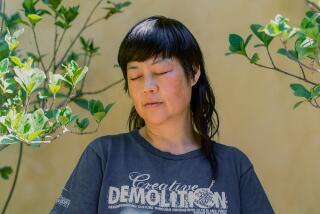Hidden in plain sight, sound, touch
Installation artist Haegue Yang believes in the “hiddenness” of stories. Using sight, sound, heat, wind, light -- sometimes even scent -- she seeks to create a sense of narrative by transmuting intimate experience into abstract sensory environments.
A Korean who lives in Berlin, Yang has created the latest such exploration in her first solo show in the U.S., “Asymmetric Equality,” at the REDCAT Gallery in Walt Disney Concert Hall through Aug. 24.
In the darkened space on a recent weekday, the petite and slim artist, dressed in a black jacket and jeans, was overseeing the final touches to an expansive amalgam of shifting patterns of shadow and light, mirror imagery, sound and warring sources of heat and air.
The multimedia installation is the manifestation of an unspoken narrative about private and public intersections, inspired by visits to L.A. for her REDCAT residency and by her interest in the emotional geography of colonialism. The late French novelist Marguerite Duras, born in Indochina, was another influence, Yang said.
“Most of the referential stories I’m interested in have something to do with my own experiences and perception,” she explained.
For example, in the recent “Siblings and Twins” in Frankfurt, Germany, her focus was Duras’ Paris apartment, where the young writer’s guests planned political actions and shared experiences and “intellectual thought.”
“There was a very blurred barrier between protected privateness and public engagement,” Yang said.
At REDCAT, that barrier is suggested once again -- this time by open horizontal blinds hanging in branch-like formations and flanked by snaking vines of looped wires connected overhead to heat lamps and electric fans.
Lights, blood-red and blue-white, circle the room, evoking both sun and searchlights. Shadows, oddly organic- and tropical-looking, appear and disappear on the white walls.
“I’m fascinated by the blind and its function of filtering light and creating a kind of half-transparent wall between two spaces,” Yang said. “It is that space between people that I’m very interested in. You are not alone. You can see other people walking through the half-shadow, half-light. You are sharing but not sharing.”
Fans and heaters are “sense devices,” which in her past work have included humidifiers and scent emitters.
“In this installation, I reduced the devices to wind and heat, because in L.A. there is warmth, but at the same time you have the breeze that’s a kind of comforting feeling,” she said. “The infrared heater also makes a red light, which you can associate with sunset or sunrise.”
Yang’s term for the atmospheric effect is “warm melancholy.” Sets of mirrors, meanwhile, serve to double, delete, reflect and filter, she said. They also suggest mental space, “which goes a little beyond the physical space.”
Finally, hidden behind a wall is a set of drums linked electronically to the circling lights, which leap and shudder with the drumbeats, providing a “primitive” voice in the abstract landscape and reflecting Yang’s interest in “the so-called colonial environment.”
“With the combination of boom, boom, boom and the red light and the filtering,” she said, “I had the image in my mind of Indochina, a humid and warm place, in the evening, when sounds from far away come to you.”
Yang, born in Seoul in 1971, has shown her work primarily in Europe and Asia but has recently begun expanding her presence in the U.S.
She will be one of the featured artists in this fall’s Prospect.1 New Orleans, a biennial of contemporary art, and is part of the Carnegie International contemporary art exhibition in Pittsburgh, for which she was one of 40 artists from 17 countries chosen.
The factor shared by the works in that show, Douglas Fogle, the Carnegie Museum’s curator of contemporary art, told the International Herald Tribune, is an expression of “intimate moments in our lives that we often miss by existing in our own worlds and not seeing what is right in front of us. At the same time, it explores our infinite sense of being part of a larger universe.”
Yang’s nomadic life, said Clara Kim, REDCAT’s acting gallery director, strongly influences such feelings.
“Through her artwork,” Kim said, “she is trying to communicate nonspecific locations as an idea and a broader sense of community.”
For Yang, it comes back to the universality of story. Or as she put it: “I fundamentally believe that what I feel can be shared without being told.”
--
--
Haegue Yang: ‘Asymmetric Equality’
Where: The Gallery at REDCAT, 631 W. 2nd St., L.A.
When: Noon to 6 p.m. or curtain time Tuesdays through Sundays
Ends: Aug. 24
Price: Free
Contact: (213) 237-2800 or www.redcat.org
More to Read
The biggest entertainment stories
Get our big stories about Hollywood, film, television, music, arts, culture and more right in your inbox as soon as they publish.
You may occasionally receive promotional content from the Los Angeles Times.










